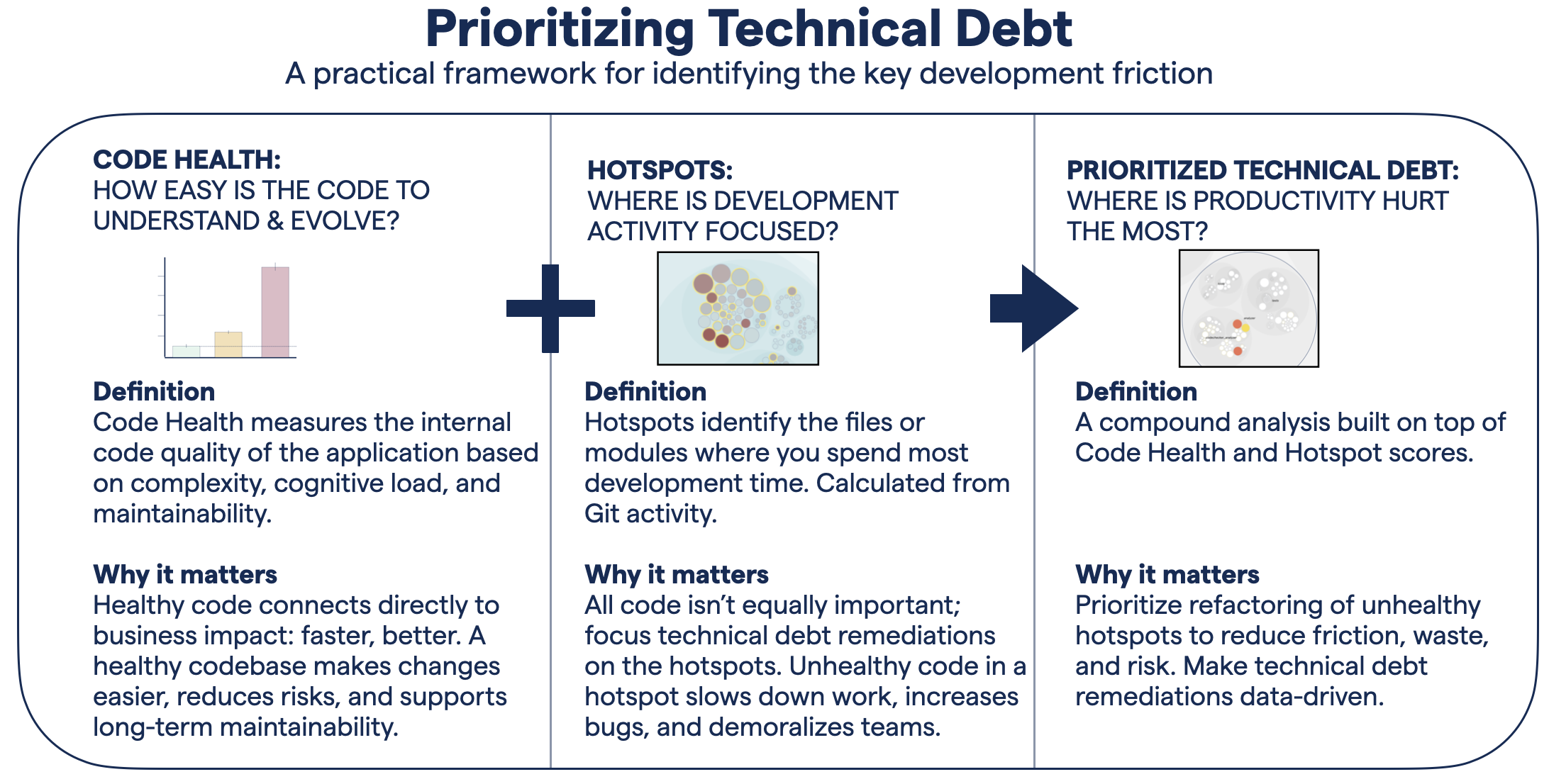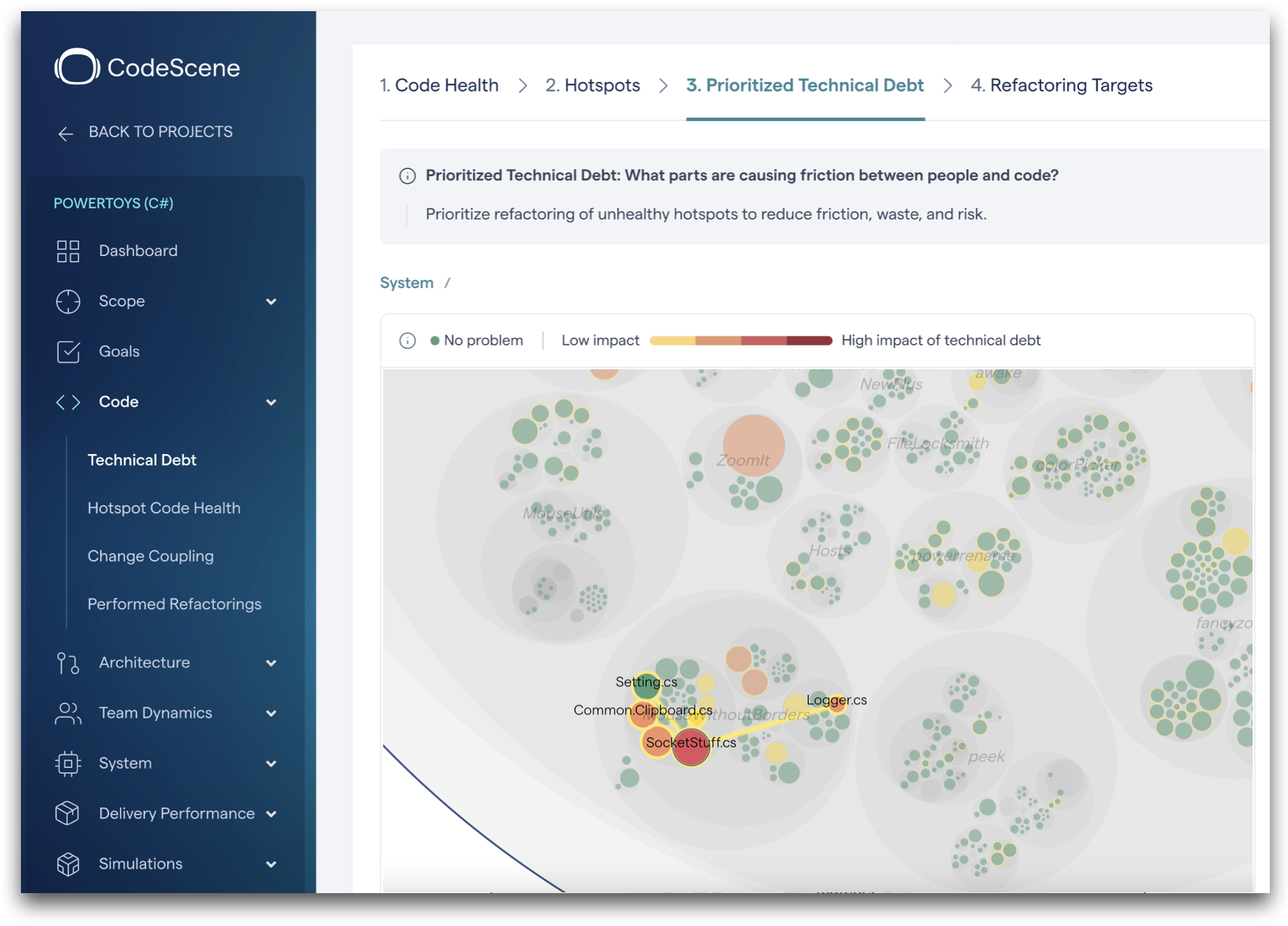CodeScene’s Framework for Managing Technical Debt: an introduction¶
Not all code is equally important. CodeScene’s strength is its ability to prioritize technical debt based on how your team interacts with the code — not just what the code looks like.
By combining Code Health metrics with development Hotspots, CodeScene pinpoints the parts of your system where poor code quality actively slows down your team. These are the areas that matter most — and where refactoring delivers the biggest impact.

Fig. 75 CodeScene’s framework for prioritizing technical debt.¶
Key benefits¶
The industry’s only code quality metric with proven business impact. (Faster, better). Code Health is validated via award-winning research. It’s a metric you can trust.
Prioritizes based on how you work with the code, not just the code itself. This is a crucial difference from traditional static analysis tools: some technical debt may be neither urgent nor impactful. Fixing that debt could be wasteful. Instead, CodeScene understands how your codebase evolves and prioritizes based on the organizational impact.
Limits recommendations to what’s relevant and actionable. With CodeScene, you’ll never get a list of 5.000 items to fix. Instead, you get a view of the most impactful technical debt. This allows you to balance improvements vs new features.
Automatically adapts to changing priorities and focus. Changing focus in your product development means that new hotspots emerge. CodeScene adapts automatically, updating its refactoring recommendations to what’s important for you now.
Proven ROI lets you build a business case for technical debt remediation. Larger improvements and refactorings can now come with a business expectation. Fixing a problematic hotspot has a proven impact on development speed and defect reduction. Use the data and models from the Code Red paper .
Complete workflow support – shift left on code quality. CodeScene’s UI is only part of the tool; CodeScene also comes with IDE extensions, automated code reviews in Pull and Merge Requests, as well as support for defining refactoring goals in the product. Oh, there’s more: CodeScene also has its X-Ray analysis which identifies hotspots at the function level. That comes in handy in case you struggle with a +1.000 lines hotspot file. This means that existing technical debt can be actively managed, and new technical debt pro-actively prevented already in the IDE.

Fig. 76 Access the analysis via the Technical Debt menu in CodeScene.¶
FAQ on Technical Debt Analysis¶
Great, but how is CodeScene different from SonarQube?¶
From a 10,000-foot view, they are both about code. Both tools claim to do “technical debt”. Yet, under the hood, CodeScene differs in three important ways:
Only CodeScene can prioritize based on organizational impact. That way, you get an actionable starting point to address the technical debt challenge.
CodeScene’s quality metric – the Code Health score – is 6x more accurate than SonarQube’s corresponding quality measure. CodeScene also reduces false positives and noise to a minimum.
CodeScene’s KPIs are the only ones that have a proven impact of developer speed and defect reduction.
The reason for these advantages is that CodeScene was built from first principles, based on real research, to specifically address technical debt. It’s a holistic approach.
Do I need other tools as well?¶
It depends on your context, but our experience is that most organizations want to monitor and control other aspects of quality, too. For example:
Use linting tools to catch style issues and common low-level bugs like null-reference problems.
Use security scanners to detect vulnerabilities.
Even though CodeScene’s metrics correlate with security vulnerabilities and risks, we aren’t a security tool.
Won’t AI fix technical debt so that I no longer have to care?¶
Code quality is more important than ever in the AI age. You need a certain level of Code Health in order to be able to apply AI-coding assistants reliably. Further, for years to come, we need code to be understandable by both humans and machines alike. We don’t want to end up in a situation where we have tons of AI-generated code that no one understands.
Check out our Guardrails for AI-Assisted Coding .
How do I make the business case for technical debt?¶
Use CodeScene’s validated statistical model that translates Code Health scores into tangible business value – faster development, fewer defects. Combine it with our industry benchmarks to get an objective assessment of where you are as a company with respect to technical debt.
Check out the examples and presentation on how to calculate the ROI for refactoring . These materials make it easy to present a compelling business case to stakeholders. With CodeScene, technical debt conversations can move from gut feeling to data-driven decision-making.